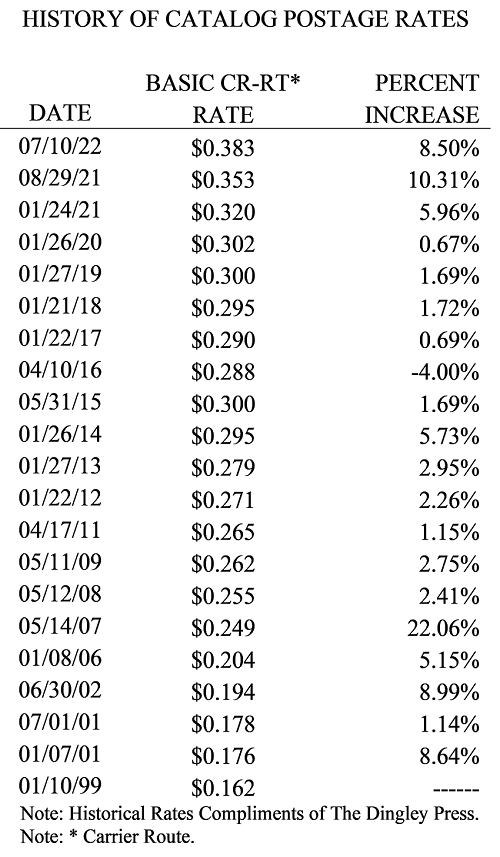Catalogers face another postage increase on July 10, the second one in 2022. Having dealt with many of these throughout my career, I thought I’d review the history of rate increases over the years and their often-devastating impact on catalogs. It is not easy to absorb these increases which often result in reduced page count and cuts in circulation to stay above water. In most cases, as the postage increases, the number of catalogs mailed decreases. The Dingley Press, Lett Direct and our industry advocate the ACMA have tried in vain for years to convince USPS officials that the US Postal Service is financially worse off by increasing rates.
Postage and paper are the largest direct selling expense categories for most catalog merchants. Postage, for example, represents approximately 50% of the cost to print and mail a catalog. That’s huge! While paper price increases have also been exorbitant, the July postage increase comes on the heels of another one this past January – a double whammy.
When I started my catalog marketing career in 1971, it cost $.08 to mail a 1st Class letter. Today, mailing that same one-ounce letter costs $.58 (increasing to $.60 on July 10th). The cost to mail catalogs has increased comparably. Let’s look at the historical rate increases.
Postage Rate Increase in 2007: Just when mailers were doing well, they were dealt a big blow when postage increased 22%. It was devastating and unexpected. This one event eliminated many of the smaller catalog businesses which simply could not absorb this rate increase. The catalogs that did survive were forced to make dramatic downward cuts in paper and format/size of their catalog. What’s more, mailers expected the printers to help them absorb the rate increase.
While it is difficult to compare historical rates, the chart below shows basic carrier route rates from 1999 to the present. There have been many changes in the rate structure, direct entry, etc. The Carrier Route class has existed during this period; therefore, it provides a general idea of the scale of USPS rate increases. Overall catalog postage has approximately doubled over the past 23 years, with the past two years being especially big. As you can see from the chart, rate increases have been frequent and mostly higher than inflation (except from 2007 to 2021 when they remained at the rate of inflation per the Postal Accessibility & Enhancement Act of 2006). In contrast, even with these horrendous increases, actual printing costs are lower than they were in 1999 as print efficiencies have improved.

In 1991, the Postal Service launched an incentive for Drop Shipping which provided an incentive to mailers to have their catalogs trucked to the BMC’s and SCF’s in exchange for significant postage discounts. This service is provided by catalog printers.
Then, along came co-mail, which helped offset net postage expense. Before off-line co-mail in 2008, there was co-binding on stitchers in early 2000. This was limited to the largest mailers. Later, the co-mail process leveled the playing field for mid-size and small catalogers. This made it possible for them to have the postage rate advantage as the larger mailers.
On January 22, 2017, the Postal Service increased the maximum weight limitation for piece rate catalogs from 3.3 to 4.0 ounces. This weight increase is one of the most significant benefits to catalogers that I have seen over the years, because in 2016, the cut-off, depending on paper weight and trim size, was approximately 60 pages, to come in weighing 3.3 ounces or less. Under the new guidelines, an 80-page catalog will still qualify at the postal piece rate if it weights 4.0 ounces or less. That means a cataloger can circulate approximately 20 more pages without incurring any additional postage cost. And, as we know, the more pages, i.e., the more SKU’s, the greater the sales. Sales will increase by approximately one-half the percent increase in page count.
We are fortunate to have the best postal system in the free world. I appreciate the work the USPS does on behalf of mailers every day. However, postage has become very expensive, negatively impacting direct mailers. No other mailing format can take the place of a mailed catalog. Not a postcard or a self-mailer, email or other online media. If the USPS would reduce postal rates, maybe catalogers would mail more. I know … wishful thinking.
